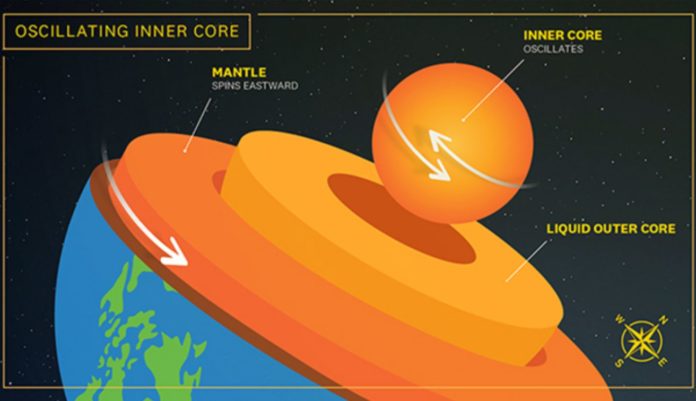New research published today reveals Earth’s six-year cycle of super- and sub-rotation that affected the length of a day.
Scientists at the University of Southern California have discovered evidence suggesting the Earth’s inner core oscillates, defying widely held beliefs that it rotates at a higher rate than the planet’s surface.
Based on an analysis of seismic data, their study, which came out today in Science Advances, shows that the inner core changed direction in the six years from 1969 to 1974. The researchers claim that their concept of inner core movement also explains the change in day duration, which has been seen to vary for decades.
“From our findings, we can see the Earth’s surface shifts compared to its inner core, as people have asserted for 20 years,” noted John E. Vidale, co-author of the study. “However, our latest observations show that the inner core spun slightly slower from 1969-71 and then moved the other direction from 1971-74. We also note that the length of day grew and shrank as would be predicted .
“The coincidence of those two observations makes oscillation the likely interpretation.”
Analysis of atomic tests shows the rate and direction of rotation
In the last 30 years, our understanding of the inner core has vastly improved. The inner core, which is a hot, dense ball of solid iron the size of Pluto, has been observed to move and/or change over time. It’s also impossible to witness directly, so researchers must rely on indirect data to explain the movement and changes’ pattern, pace, and reason.
The initial study, published in 1996, proposed that the planet’s inner core rotates at a rate of around 1 degree per year faster than the rest of the world, a phenomenon known as super-rotation. Vidale’s subsequent findings confirmed that the inner core super-rotates, albeit at a slower rate.
Wei Wang and Vidale used data from the Large Aperture Seismic Array (LASA), a US Air Force facility in Montana, to discover that the inner core spun at a slower rate than previously thought, about 0.1 degrees per year. The study used a novel beamforming technique developed by Vidale to evaluate waves created by Soviet underground nuclear bomb explosions in the Arctic archipelago Novaya Zemlya from 1971 to 1974.
The latest discoveries came from Wang and Vidale applying the same methodology to two previous atomic tests — Milrow in 1969 and Cannikin in 1971 — that took place beneath Amchitka Island at the point of the Alaskan archipelago. They determined the inner core has reversed direction, sub-rotating at least a tenth of a degree every year, by measuring the compressional waves caused by nuclear explosions.
With this latest study, seismologists were able to see for the first time that the well-known six-year oscillation was real.
“The idea the inner core oscillates was a model that was out there,” Vidale adds, “but the community has been split on whether it was viable.” “We went into this expecting to see the same rotation direction and rate in the earlier pair of atomic tests, but instead we saw the opposite. We were quite surprised to find that it was moving in the other direction .”
Future studies will investigate inner core formation
Future study, according to Vidale and Wang, will be contingent on finding sufficiently accurate observations to compare against these findings. Wang says that they were able to find the exact location and time of the very simple seismic event by using seismological data from past atomic tests. But the Montana LASA shut down in 1978, and underground atomic tests in the United States are no longer done. This means that researchers would have to use earthquake data that isn’t as accurate, even though instruments have gotten better in recent years.
The findings back up the notion that the inner core oscillates due to variations in day length — plus or minus 0.2 seconds over six years — and geomagnetic fields, which both match the theory in terms of amplitude and phase. According to Vidale, the data provide a persuasive theory for many of the scientific community’s questions.
“The inner core is not fixed — it’s moving under our feet, and it seems to going back and forth a couple of kilometers every six years,” explains Vidale. “One of the questions we tried to answer is, does the inner core progressively move or is it mostly locked compared to everything else in the long term? We’re trying to understand how the inner core formed and how it moves over time — this is an important step in better understanding this process.”
Image Credit: EDWARD SOTELO/USC
You were reading: New Research Shows: Earth’s Inner Core Oscillates
